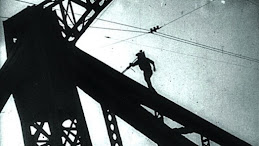Short Take: Vertov’s “The Man with the Movie Camera”
Dziga Vertov is not enough well known outside film historian circles and if you only see one of his films let it be this one.
“The Man with a Movie Camera” was disparaged and dismissed on its release ninety-three years ago. Eisenstein found it pointless (which still surprises me, but he could be crusty); Vertov’s fellow Soviets found it an example of bourgeoise pretension (despite it being in Vertov eyes an ode to the Russian Soviet people and the workers who were the backbone of the state). However, time not only heals all wounds (I don’t make up the cliches, I just use them), but does provide correctives to knee-jerk reactions.
In the ensuing years, the film’s reputation has gained as a piece of “pure cinema”, very much what Vertov was trying to get at. It succeeds admirably and while it eschews interstitial dialog and a linear narrative, there is a structure at hand, and a narrative progression. It is not a thematically dense film, but it is gorgeous (and fun!) to watch. And it is barely over an hour long.
It’s also telling that for a film this visually arresting, few are the still photos from it that would do justice to the kinetic nature of the work, which is frankly, also the point. Few movies are so fully aware that they are their own medium to such degree. As with the best cinematic achievements, “The Man with a Movie Camera” works on several levels and is surprisingly post-modern in its insistence on remind the audience that they’re watching a film (a great one, at that).
It’s not difficult to see how it gained the reputation it has. Almost every editing and narrative technique in the film has a corresponding resonance in films from the French New Wave to Tarantino. I don’t know that Hitchcock or Welles ever saw it or if they did, what their thoughts were on the piece, but it wouldn’t surprise me if they had. To be sure, Hitchcock did pay his debt to cross-cuts and editing to build up suspense to Eisenstein, so I would be surprised if he hadn’t seen Virov’s opus.
I suppose narratively, the film it has the most in common with would be something like Murnau’s “Sunrise”, but there are no central characters here that occupy the screen. The main precursor would be Virov’s own “Berlin: Symphony of a Metropolis”, but Vertov had already been working with his techniques years before.
And what techniques: double exposure, smash cuts, jump cuts, split screen, slow motion , reverse motion, and more, all in a defiantly non-linear progression. There is an element of the fantastical in Vertov’s creation of a singular “city of the future” sewn together via purely documentary technique. (One of the tenets of the kinoks/“cinema-eyes” filmmakers was to do away with all non-documentary filmmaking; a radical, if doomed, idea.)
Ironically, Vertov and his cohort (his wife Yelizaveta Ignatevna Svilova, a noted filmmaker in her own right was the editor, and Mikhail Kaufman - Vertov’s younger brother, was the cinematographer) were all striving to erect a new language of film based on Marxist dialectic ideology (perhaps another reason Eisenstein didn’t care for the film; they may have beat him at his own game of editing as visual dialectic).
The restoration from Kino is available on Amazon and the Criterion Collection has it, as well. There is a completely silent version available on YouTube and the Internet Archive, but I would heartily endorse renting it to get the full experience. For the record, I have watched it sans soundtrack and it works as a purely visual experience, but to be sure, Vertov envisioned his opus presented with a score and the Kino-Loder (I think) restoration has a score by Michael Nyman. They also have the Criterion Collection’s version with other accompaniment.
Vertov did have a fairly successful career after his masterpiece and died too soon from cancer at 58. Admittedly, his films post-“Man” were made under Stalin’s regime and edited according to prevailing propaganda principles, but they are worth checking out. “Three Songs About Lenin” was subjected to edits under Stalin (removing Stalin’s “enemies” from the footage) but was restored by Svilova in 1970. It’s worth seeking out.
I tout silent cinema works because, of course, they are worth seeing just for themselves, but also because we develop a sense of continuity across the decades of how our cinematic language has developed. I should actually say “languages” since film as an art is as diverse as the people who make it.
Vertov is a seminal figure in this continuity and an hour of your time to discover him is an hour well spent.
While some of the following images are striking, they do little to convey their power in movement. Click on the image to view enlargement.










Comments
Post a Comment